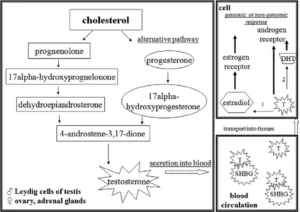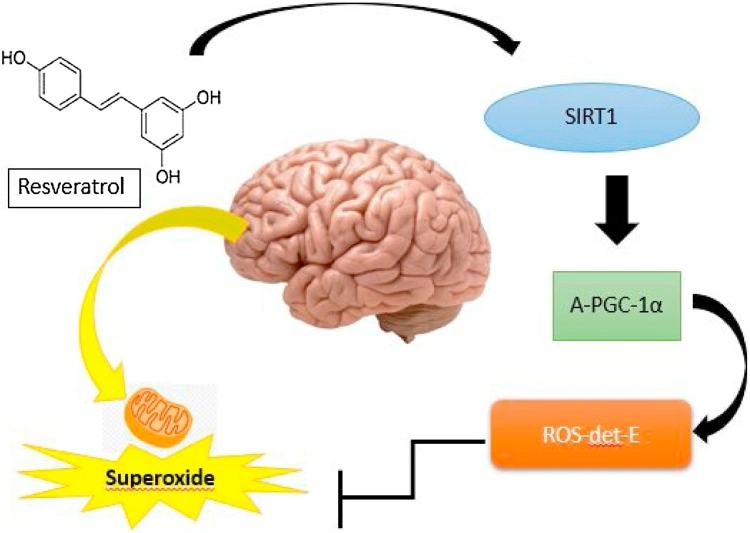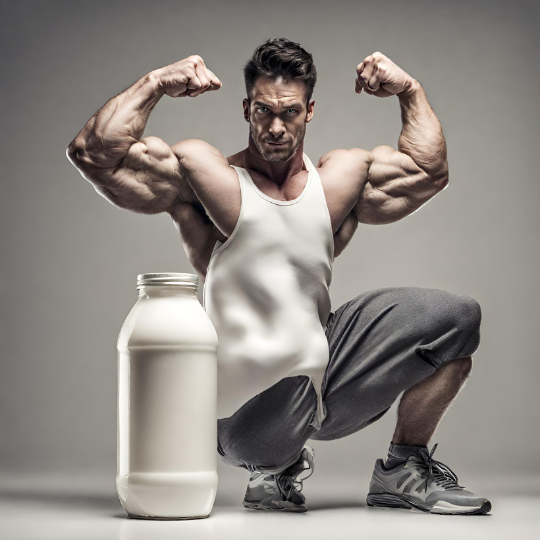Have you heard about testosterone and how it makes men “manly” or estrogen and how it makes women “be a girl”? Testoterone and estrogens are more than about manhood and “being hormonal”.
Androgens and estrogens are two classes of hormones that play an important role in the human body. Both androgens and estrogens are steroid hormones, meaning they are derived from cholesterol and have a specific chemical structure that allows them to bind to specific receptors in cells. Androgens and estrogens are involved in the development and maintenance of reproductive tissues and processes, but they are also involved in bone health, and other physiological processes.
Androgens
Androgens are hormones that stimulate the development of male characteristics, such as facial and body hair, a deeper voice, and increased muscle mass. The main androgen hormone in males is testosterone, which is produced by the testes. Females also produce testosterone, but in much smaller amounts. It is produced in the ovaries and the adrenal glands. Androgens could also be converted to estrogens in the body through a process called “aromatization” (Alemany, M. 2022).

Estrogens
There are three main types of estrogen hormones: estradiol, estriol, and estrone. Estradiol is the most potent and biologically active form of estrogen, and it is produced mainly by the ovaries in females. Estriol and estrone are less potent, and they are produced in the liver and adipose tissue in females. Estrogens are crucial for the menstrual cycle, pregnancy and the development of female secondary sexual characteristics, such as breast and wider pelvis structure (Alemany, M. 2022).
Both androgens and estrogens are metabolized in the liver and other tissues, and they are excreted through the urine and feces. The metabolism of androgens and estrogens is regulated by enzymes such as aromatase, in charge or aromatization, and 5-alpha reductase, which converts testosterone to dihydrotestosterone (DHT), the functional form of testosterone.
The levels of androgens and estrogens in the body are also regulated by sex hormone- binding globulin (SHBG), a protein produced by the liver that binds to androgens and estrogens in the blood, and regulates the concentration of free form hormones in blood and their utilization by the cells (Alemany, M. 2022).
Hormone’s effects
Androgens and estrogens have a variety of effects in the human body, depending on the specific hormone and where it acts. As mentioned before, androgens are in charge of developing male secondary sexual characteristics, the maintenance of muscle mass and bone density, as well as regulating sex drive and even humor. On the other hand, estrogens regulate the menstrual cycle and pregnancy, they induce female secondary sexual characteristics, and they help with the maintenance of bone density and absorption of calcium. In addition, estrogens have been shown to have protective effects in the body, such as reducing the risk of heart disease and improving cognitive function (Alemany, M. 2022; Simó R, et al, 2015).
Interactions between androgens, estrogens, and SHBG are complex and have a wide range of effects on the body. For example, low levels of SHBG can lead to increased levels of androgens and estrogens in the body, while high levels of SHBG can lead to a decrease in levels of these hormones. This increments and decreases of hormone levels can lead to adverse effects, such as low sex drive in men, and an irregular menstrual cycle, difficulty to get pregnant, and even Polycystic Ovary Syndrome (PCOS) in women (Simó R, et al, 2015).

Genes and Hormones
As always, genetic predisposition can influence how hormones are produced and utilized. Individuals with certain variants of the SHBG gene may have lower or higher levels of SHBG, which can affect the levels of androgens and estrogens in the body and potentially increase the risk of certain health conditions. Here are some SNPs that could affect hormone’s metabolism:
- SHBG gene: this gene codes for the protein Sex Hormone-Binding Globulin (SHBG). This protein, as mentioned before, regulates the levels of androgens and estrogens in the blood:
- SNP rs6259 may influence the metabolism of SHBG independently of Body Mass Index, androgenic and insulin-related features in women with PCOS (Xing, et al. 2022).
- SNP rs6259 may also cause changes in placental SHBG concentration and may play a functional role in the molecular mechanisms of Gestational Diabetes Mellitus (Zhang, X. et al., 2018).
- SNP rs11252845 is associated with prostate cancer aggressiveness; this is caused by the association between SHBG and plasma testosterone levels (Sun T. et al, 2011).
- Aromatase (CYP19A1) gene: this enzyme converts androgens into estrogens in the body. Variants in the aromatase gene have been associated with differences in estrogen metabolism and levels, as well as an increased risk in certain conditions such as breast cancer.
- SNP rs2414096 has been associated with hyperandrogenism, such as hair loss and an increases susceptibility to PCOS (Yip L, et al. 2009; Jin, JL.et al, 2009).
- SNP rs700518 has been associated with the risk of osteoporotic vertebral fractures in postmenopausal women (José A. et al. 2007).
Nutritional aids
There are several behavioral, nutritional, and supplementary approaches that may help to address genetic predispositions related to androgen and estrogen levels and improve health and longevity. First, by incorporating regular physical activity into your daily life. This can help to maintain healthy levels of SHBG and hormones in the body. Second, a balanced diet, rich in fruits, vegetables and other plant-based foods may also help to support hormonal balance and overall health. There are certain nutrients with special interest for balanced hormonal levels, such as omega-3 fatty acids, magnesium, and zinc, which has been shown to have beneficial effects on hormonal balance and may be useful for individuals with the genetic SNPs mentioned before.

In addition, there are certain supplements that may also be helpful in supporting hormonal balance and overall health. For example, lignans and isoflavones, extracted from foods such as flaxseeds, soybeans, an nuts. These compounds have been shown to have estrogen-like effects in the body, which might support hormonal balance (Lambert MNT, et al. 2017).
Other supplements such as DIM (diindolymethane), derived from cruciferous vegetables, has been shown to have beneficial effects on estrogen metabolism and also with preventing and treating breast cancer (Williams DE, 2021). Last but not least, inositol is also a very special supplement for hormonal balance, liver and brain function, insulin signaling and ion-channel permeability, maintaining overall health (Kiani AK, et al. 2021).
To summarize, hormones, such as testosterone and estrogens, are vital for a correct function of our bodies, and an imbalance in them could derive in serious health effects. Remember that you can book a free appointment with us to address your hormones and possible SNPs you may have, via our genetic and metabolic optimization approach. This would start you on a journey to a healthy long life.












